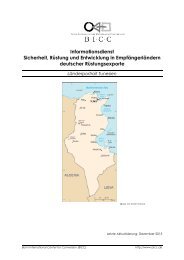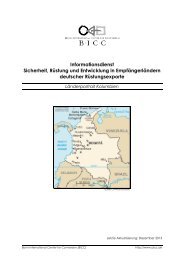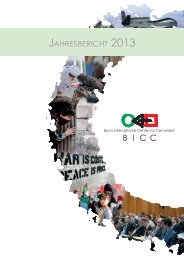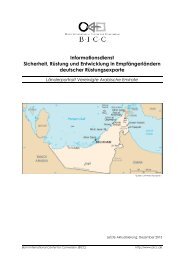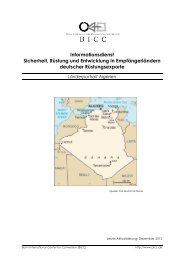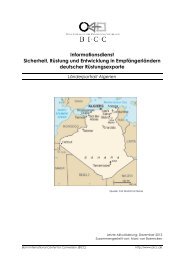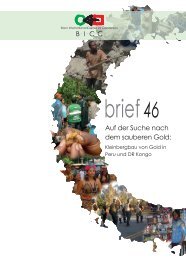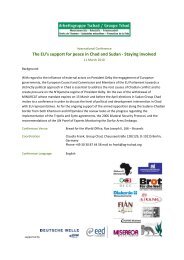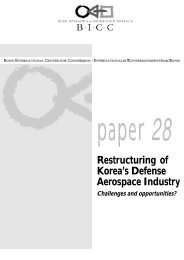English - BICC
English - BICC
English - BICC
You also want an ePaper? Increase the reach of your titles
YUMPU automatically turns print PDFs into web optimized ePapers that Google loves.
eing used to facilitate the conversion<br />
of paramilitarism. What has been<br />
stated about the arms issue, namely<br />
that the symbolic value of guns<br />
surpasses their inherent military<br />
potential, is also true for Northern<br />
Ireland’s paramilitary organisations. It<br />
will require a high degree of sensitivity<br />
from inside and outside the<br />
organisations to adequately deal with<br />
their cultural legacies and devastating<br />
past, and to define routes into civil<br />
society. Apart from the experience of<br />
ex-prisoners’ (re)integration during the<br />
Troubles, and particularly in the<br />
context of the 1998 Agreement’s early<br />
release formula (Gormally, 2001), no<br />
comprehensive approach towards<br />
alternative civilian options for<br />
members of paramilitary groups has<br />
been developed in Northern Ireland.<br />
Unlike several other post-conflict<br />
scenarios in Africa and Central<br />
America, the decommissioning debate<br />
occurred in the absence of any concept<br />
or programme of demobilisation or<br />
ex-combatant reintegration; neither<br />
was there any relevant demand for the<br />
integration of ex-militants into<br />
Northern Ireland’s security forces, a<br />
policy implemented in South African,<br />
where former paramilitaries were<br />
subsumed into the army (MacGinty<br />
and Darby, 2002, p.101).<br />
The transformation and conversion of<br />
paramilitarism in Northern Ireland—a<br />
peace dividend not yet redeemed—may<br />
take on various characteristics and<br />
features in the future:<br />
From inside, the positive elements<br />
within the paramilitary organisations<br />
will have to develop more strength<br />
and creativity to civilise their culture<br />
and confront violence by means of<br />
community awareness and<br />
community watch operations<br />
instead of vigilantism; voluntary<br />
forms of community based arms<br />
control may lay the groundwork for<br />
further decommissioning.<br />
Civil society, both organisations and<br />
individuals, may be asked to more<br />
proactively take “local ownership”<br />
of this process, especially at the<br />
interfaces of the two communities.<br />
Politicians must endeavour to<br />
enhance political inclusion, augment<br />
social and economic integration, and<br />
develop a more efficient system to<br />
sanction and prosecute crime.<br />
Economies which fuel violence have<br />
to be dried out.<br />
Silent spring 2002?<br />
For 2002, the overall picture for<br />
Northern Ireland’s peace process does<br />
not appear all that gloomy after all.<br />
This is especially apparent when one<br />
compares the relatively tranquil spring<br />
of 2002 with the crisis-ridden springs<br />
of previous years. Although the<br />
beginning of 2002 was rife with<br />
problems, they were not monolithic or<br />
intractable in nature; it appears that a<br />
more relaxed atmosphere has<br />
descended over the province. There<br />
have been many encouraging signs in<br />
recent months that the peace process is<br />
gaining momentum: January rallies<br />
have shown civic society’s potential to<br />
intervene; the emergence of a Loyalist<br />
“think tank” indicates a new political<br />
voice that may present alternatives to<br />
violence (Sunday Tribune, 20 January 20,<br />
2002); and the dissident Republican<br />
group INLA has recently offered to<br />
“talk peace with the UDA” (Belfast<br />
Telegraph, 10 February 2002).<br />
B·I·C·C<br />
cultures and markets of<br />
violence<br />
Accordingly, questions whether it is<br />
“time for an Ulster truth commission”<br />
(Belfast Telegraph, 10 February 2002)<br />
have been raised more loudly. The<br />
changing atmosphere in the province<br />
was reflected in a significant statement<br />
of Gerry Adams at the World<br />
Economic Forum in New York: “I<br />
don’t think we can force on unionism<br />
an all-Ireland state that doesn’t have<br />
their assent or consent and doesn’t<br />
reflect their sense of being<br />
comfortable” (The Irish Times, 5<br />
February 2002).<br />
Four years after the Good Friday<br />
Agreement, there is no doubt that the<br />
process of burying the hatchet has<br />
commenced. Leaving behind violence<br />
during a peace process is not only<br />
about arms, the bad guys that use<br />
them, or the victims who suffer from<br />
them; it is about the roots of a conflict<br />
that has hindered the political<br />
representation and inclusion of divided<br />
identities; about the achievement of<br />
political goals which were partly<br />
pursued by violence, about the<br />
recognition of these goals that spurred<br />
the armed struggle; about justice and<br />
the healing of wounds inflicted by<br />
violence and violations of human<br />
rights; and about the adoption of a<br />
new approach to the past with the<br />
purpose of building a better future.<br />
A Divided Society: A ‘‘peace line’’ in Belfast (2001). Photo: Corinna Hauswedell<br />
67



